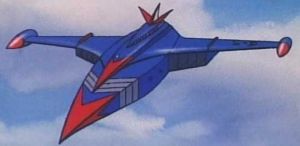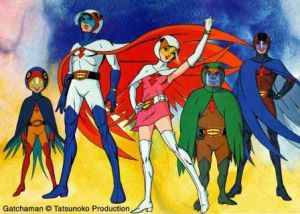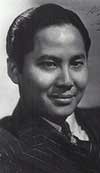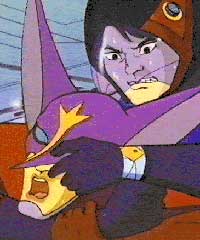- Comics
- Comics Reviews
- Manga
- Comics Reviews
- European Comics
- News
- Comics News
- Press Releases
- Columns
- Spotlight
- Digital Comics
- Webcomics
- Cult Favorite
- Back Issues
- Webcomics
- Movies
- Toys
- Store
- More
- About
By Philip Schweier
July 3, 2012 - 13:59
In the late 1970s, following the big screen debut of Star
Wars, science fiction fans were clamoring for more. The most notable
follow-ups were Battlestar Galactica on television and Star Trek: The Motion Picture
on the big screen. But for fans of animated shows, there was virtually nothing
at all until Sandy Frank imported Battle of the Planets from Japan.

The Phoenix
The show, originally titled Science Ninja Team Gatchaman, was
produced in 1972 by Tatsunoko Production Company. Tatsunoko had enjoyed a
healthy track record of success, producing such popular shows as Speed
Racer and Kimba the White Lion. Gatchaman
ran for two seasons, a total of 105 episodes, and spawned a radio show and a
feature film.
The series chronicled the adventures of five teen-age ninja super-heroes –
precursors of Power Rangers – against the evil forces of Galactor and its
endless supply of giant-sized robots, led by the costumed foe Berg Katse.
In 1977, the company chose to market Gatchaman
to the world at the Marché International de Programmes in Cannes, France. This
was an international conference created for the marketing of television
programs on an international level. In attendance was Sandy Frank, a former NBC
executive who had formed his own company marketing syndicated programming to TV
stations. He had successfully sold programming to the secondary market in the
form of older programs, game shows and variety shows.
Frank saw potential in Gatchaman, and
upon his return to the States, he immediately put the wheels in motion to
acquire the rights to produce an English language version, as well as broadcast
rights throughout much of the world.
However, the series required extensive changes in order to make it
marketable. First, the title was change to Battle of the Planets,
capitalizing on the wording’s similarity to the title Star Wars. This, of
course, required the basic premise of the show to be adjusted. Berg Katse was
rechristened Zoltar, commander of the forces of Spectra. Zoltar is determined
to take over Earth and control its resources for the benefit of his dying
homeworld.
Zoltar’s threats usually came in the form of giant robotic crabs, squids and
other threatening creatures wreaking havoc on Earth and its allies. If Zoltar
didn’t control the vehicles himself, they were usually under the command of
some similarly costumed underling. Meanwhile, the minions of Spectra were clad
in two-toned green jumpsuits with bellbottoms and demonic masks, and sported
the long hair styles of the early 1970s.
Defending Earth is G-Force, a team of teenagers endowed with
enhanced physical abilities due to their cerebonic implants. Their costumes
followed a bird motif, complete with wing-like capes and beak-shaped visors on
their helmets: Mark (the eagle), Jason (a condor), Princess (the swan), Keyop
(a swallow) and Tiny (a horned owl).

G-Force: Keyop, Mark, Princess, Tiny and Jason
Mark was everything desired in a team leader: fearless and level-headed. In
contrast, his second-in-command was a bit of a hot-head. Like his costume
suggested, Jason was a predator; a crack shot and an expert driver in his race
car. Princess, the token female of the group, provided a love interest for
Mark, and though their unrequited feelings were reciprocated, they never acted
upon them. Both were too dedicated to the team to allow personal interests to
interfere.
Keyop was the most junior member of the group. Unlike his teammates, he was
created in a lab, resulting in a peculiar speech pattern of chirps and burbles.
Tiny was a big-hearted lug who wasn’t as agile as the others, but he
compensated with his enormous strength. Supporting G-Force was Security Chief
Anderson, the man who cultivated and developed the team and served as their
boss.
All the members had their own personal means of transportation – a jet, a
race car, a motorcycle or an all-terrain buggy – but none of them compared to
the Phoenix, the team’s powerful
spaceship, piloted by the husky Tiny. It was heavily armed and in times of
extreme danger, it could convert into a fiery bird-like entity, but this would
prove draining on the team, both mentally and physically.
Many of the original stories featured what in those days was considered an
disagreeable level of violence. In producing a show acceptable to American
markets, Frank knew immediately that the episodes would not only have to be
translated but often rewritten. The violent portions of the episodes were
edited out and replaced with expository footage featuring 7-Zark-7, G-Force’s a
robot that served as the team’s “computerized coordinator.”
Zark’s bulbous configuration was reminiscent of R2D2, though
sometimes this resemblance was lessened when he wore his G-Force-style costume,
complete with cape and visored helmet. These animated sequences were produced
by Hanna-Barbera and provided a sharp contrast to the distinctive
Japanese-style animation.

7-Zark-7, the robotic coordinator of G-Force
From his control room in the undersea base known as Center Neptune, Zark and
his robotic dog, 1-Rover-1, provided a bit of light comedy, often aided by the
sultry-voiced early warning system SUSAN, calling from the edge of the solar
system. Zark also kept the show family-friendly by making it clear to more
impressionable members of the audience that any vehicles destroyed by Spectra
were under robotic control, and any cities that suffered mass destruction had
been completely evacuated beforehand. Thus, no lives were ever lost.
There was also a stock sequence of the team relaxing in their ready room. Mark
and Jason played ping-pong while Princess and Keyop jammed on bass and drums
respectively. Tiny enjoyed a feast of “space burgers,” only to be interrupted
by Zark’s call to duty.
In addition to the glaring difference in animation provided by the Tatsunoko
and Hanna-Barbera companies, it was also obvious that the series was originally
intended to be completely Earth-bound. All of the worlds that formed the
Intergalactic Federation of Peaceful Planets were Earth-type in environment,
right down to the modern cities that easily could have been any metropolitan
center on Earth.
Another challenge in the reworking of the show for the English-language market
came down to simple timing. In most animated programs, dialogue is recorded
prior to production, and animators coordinate the characters lip movement to
reflect the dialogue. With Battle of the Planets, dialogue
had to be written and performed in sync with the established animation.
Nevertheless, the writing of the series was much more ambitious than most
cartoons being produced at the time. Chief among the show’s writers was Jameson
Brewer, a veteran of the Hanna-Barbera company. Over the years, he had been a
writer, director, producer and a voice director. His experience was just what
Frank needed to handle the challange of “re-creating” the successful Japanese
cartoon.
Another veteran of the Hanna-Barbera studio was music director Hoyt Curtin,
known for composing such jazzy themes as Jonny Quest and The
Jetsons. He was hired to create musical cues to compliment the score
created by Bob Sakuma, Gatchaman’s
original composer. Curtin’s work on Battle of the Planets calls to
mind some of the orchestral work he did on such programs as Super
Friends and The Herculoids.
The principal actors for Battle of the Planets were all
experienced voice over artists. They were often called on to provide multiple
voices for many roles, as well as intermittent peripheral characters. Mark was
voiced by animation veteran Casey Kasem, and Ronnie Schell portrayed Jason.
Janet Waldo, perhaps most widely known as the voice of Judy Jetson, played
Princess, as well as SUSAN and many other female characters. Alan Young, who
had starred as Wilbur Post on the classic sit-com Mr. Ed was featured
as both Keyop and Zark. Alan Dinehart provided the voices of Tiny and
Security Chief Anderson. Rounding out the cast was Keye Luke, remembered as Charlie
Chan’s #1 son, as well as Master Po on the television series Kung
Fu. In addition to Zoltar, he also provided the voices of the
Luminous One, Spectra’s mysterious ruler, and G-Force’s recurring ally
Commander Kronus.

Keye Luke, c. 1940
Kronus was a master pilot of the planet Riga. Later it was revealed that Kronus
was Mark’s father (The Sky is Falling, parts 1 and 2), just before
sacrificing himself to defeat Zoltar’s latest plan to conquer Earth. Such drama
was one of the elements that elevated the stories above the usual animated fare
of the era. Throughout the series, it wasn’t uncommon for the team to suffer a
catastrophic loss at the hands of Zoltar and his forces. The Phoenix was destroyed at least twice, (The
Sea Dragon and Raid of the Space Octopus), only to be reborn each
time.
Perhaps the most dramatic moment in the series was the eventual
unmasking of Zoltar, though it only deepened the mystery behind the villain. In
the episode The Alien Bigfoot, a mane of long blonde hair is revealed as
his cowl is peeled off, but the Luminous One interfered and spirited
Zoltar away in a blinding flash of light.

Zoltar about to be unmasked by Jason
One of the most heart-breaking episodes is one Battle of the Planets
fans will never get to see: the death of Jason. Of the 105 episodes of Gatchaman produced, 85 were translated
for the English-language market. According to G-Force: Animated (The Official
Battle of the Planets Guidebook), this allowed for five episodes a
week for 17 weeks
Nevertheless, Jason (named Joe in the original Japanese version) would be
resurrected as a cyborg when Tatsunoko produced a sequel Gatchaman series in 1978. A year later, a third series was
launched. The team’s costumes were redesigned slightly and Berg Katse was
replaced by a new villain, Gel Sadra. Though fans of Battle of the Planets are passionate and eager to see more, the two
sequel series were less than satisfying when they were imported to the United
States under the title Saban’s Eagle Riders. Eagle
Riders has no association with
Battle of the Planets other
than a shared production heritage.
While the Japanese animation style may seem woefully out of date, especially in
view of the early 1970s fashions featured on the series, it is the show’s goal
of higher drama that makes it stand out among most cartoons of its time. It is
very likely it influenced such popular comic books such X-Men and the New Teen Titans.
Unfortunately, only a handful of episodes are currently available on official
DVD releases. However, there are no doubt a number of bootleg versions available
via the Internet.
Still, Battle of the Planets fandom runs very high, especially in
Europe where there were entire lines of merchandise in the form of toys, lunch
boxes and coloring books. In 2002, cast members Casey Kasem, Janet Waldo and
Ronnie Schell were guests at Comic Con International, held each summer in San
Diego, CA. Though no strangers to the fame of show business, they were
overwhelmed by the response from fans that fondly remember a show in which they
were featured more than 30 years ago. “We were mobbed,” said Schell on the Battle of the Planets Ultimate DVD boxed
set.
“It was really a revelation to see the number of people that are into that
show,” said Kasem. “It’s nice to know your work is appreciated by so many
people.”
It’s easy to assume that a cartoon aimed at the youth market wouldn’t require
much effort from the actors. They are professionals, and delivered just as they
would for any assignment. The fact that it provided a wonderful opportunity to
hone their voice-over skills and enjoy some camaraderie was icing on the cake,
and they remember the show with a great deal of fondness.
Echoing the sentiments of Waldo and Kasem “It was really a fun time,” Schell
said of his experience. “I’m thinking back on my career and I would have to put
Battle
of the Planets up there.”
Praise and adulation? Scorn and ridicule? e-mail me at
philip@comicbookbin.com